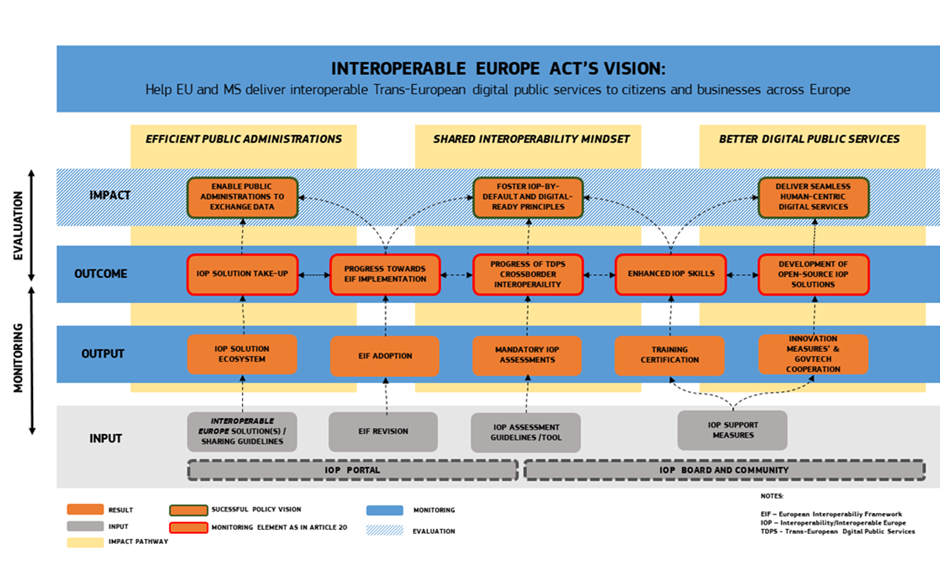
This consultation will inform the work to prepare the Interoperable Europe Agenda – the Union’s main instrument for coordinating priorities for interoperability solutions and setting out the roadmap for implementing the Interoperable Europe Act.
We invite you to be an integral part of shaping the future of trans-European digital public services!
This is your chance to contribute valuable insights that will guide the Interoperable Europe Board in prioritising cross-border interoperability enhancements. Join us in this important endeavour to create seamless and efficient digital public services throughout Europe. Your input matters, and together, we can drive meaningful change.
The consultation provides context to Regulation (EU) 2024/903, the role of the Interoperable Europe Board, as well as the various topics within the Interoperable Europe Agenda as per Article 19 of the Interoperable Europe Act highlighting the latest developments and updates.
Deadline for submission extended: 17 July 2025.
“After organising a public consultation process through the Interoperable Europe portal, the Board shall adopt, each year, a strategic agenda by which to plan and coordinate priorities for the development of cross-border interoperability of trans-European digital public services. The Interoperable Europe Agenda shall take into account the Union’s long-term strategies for digitalisation, existing Union funding programmes and ongoing Union policy implementation.” (Article 19 of the Interoperable Europe Act)
By doing so, it aims to enable stakeholders to engage meaningfully with the consultation process, a collaborative effort toward enhancing interoperability across Europe. Open to everyone, it encourages input from a wide array of stakeholders, including the Interoperable Europe Community, interoperability coordinators, and public administrations at all levels.
1. The Interoperable Europe Act and the Interoperable Europe Board
The Interoperable Europe Act, supported through the Digital Europe Programme (DIGITAL), aims to enhance cross-border interoperability and cooperation within the European Union's public sector. To achieve this, the Act establishes a new governance framework between Member States and the Commission to jointly address issues concerning cross-border interoperability and trans-European digital public services. Within this framework, Member States and the Commission agree on key priorities for shared interoperability solutions and the related support measures. Moreover, the Act mandates that European Institutions, along with public sector bodies and agencies, conduct interoperability assessments. This ensures that digital and interoperability considerations are incorporated early in the policy-making and digital public service design stages. The Interoperable Europe Board has adopted guidelines for interoperability assessments and the European Commission developed an online tool to produce and publish interoperability assessment reports.
Key terms and definitions
Regulation (EU) 2024/903 of the European Parliament and of the Council of 13 March 2024 laying down measures for a high level of public sector interoperability across the Union (Interoperable Europe Act).
Cross-border interoperability means the ability of Union entities and public sector bodies of Member States to interact with each other across borders by sharing data, information, and knowledge through digital processes in line with the legal, organisational, semantic and technical requirements related to such cross-border interaction" - Article 2(1) IEA.
Trans-European digital public services are 'digital services provided by Union entities or public sector bodies to one another or to natural or legal persons in the Union, and requiring interaction across Member State borders, among Union entities or between Union entities and public sector bodies, by means of their network and information systems.’ - Article 2(2) IEA.
Interoperability solutions include conceptual frameworks, guidelines, reference architectures, and technical specifications. They can also entail services, applications, and documented technical components like source code or AI models, provided they address legal, organisational, semantic, or technical aspects of cross-border interoperability.
Interoperability assessments are evaluations required by Article 3 of the Interoperable Europe Act. They ensure that binding requirements for trans-European digital public services consider cross-border interoperability issues before implementation. These assessments are crucial because they facilitate seamless digital interactions among public organisations, which is essential for the mobility of citizens and businesses across the EU. Interoperability assessments cover legal, organisational, semantic, and technical dimensions, addressing challenges such as different legal frameworks, organisational structures, data content and structures, and technical resources among Member States.
Online tool to perform or upload an interoperability assessment available here.

Figure 1. Interoperable Europe Act intervention logic (Source: Joint Research Centre)
Central to the governance of this framework is the Interoperable Europe Board, established under Article 15 of the Act. The Board comprises one representative from each Member State and the European Commission, with the latter serving as the Chair. Observers from entities such as the Committee of the Regions, the EU Agency for Cybersecurity (ENISA), and the European Cybersecurity Competence Centre also participate. The Interoperable Europe Board will steer the Interoperable Europe Agenda, facilitate the development of the general direction of the Interoperable Europe structured cooperation in promoting the digital interconnection and interoperability of public services in the Union and oversee the strategic and implementation activities related to that cooperation.
2. The Interoperable Europe Agenda
The Interoperable Europe Agenda is a pivotal instrument adopted annually by the Interoperable Europe Board to plan and coordinate priorities for the development of cross-border interoperability of trans-European digital public services. The objective of the Agenda is to strategically plan and coordinate priorities that align with the broader goals of facilitating seamless digital interactions across Member States. It considers the European Union's long-term digitalisation strategies, capitalises on existing Union funding programmes, and aligns with ongoing policy implementations at the Union level, ensuring a cohesive and future-ready interoperability framework.
The topics of the Interoperable Europe Agenda are structured to address multiple facets of enhancing interoperability. It includes:
1. Ongoing and planned Interoperable Europe support measures
Chapter 3 of the Act outlines Interoperable Europe Support Measures, which include policy implementation support projects, assisting Member States in aligning with interoperability standards and best practices; innovation measures, initiatives aimed at fostering the development and adoption of innovative interoperability solutions; interoperability regulatory sandboxes, which provide a controlled environment for testing new technologies and legal frameworks; training and peer review programmes to promote knowledge sharing and capacity building. The Agenda will list the measures already running and identify priorities for future ones.
2. Follow-up actions to innovation measures including support of open-source interoperability solutions
This topic delves into effective follow-up innovation measures, which are essential to drive progress in public administration and ensure that innovations are sustainable, interoperable and continuously improved. Although not yet fully established in the Interoperable Europe Agenda, several promising initiatives are already in place to foster innovation, including:
- GovTech initiatives
- Promotion of open-source solutions
- Adoption of innovative technologies, such as AI
3. Synergies with other relevant Union and national programmes and initiatives
This area seeks to identify end enhance synergies between the Interoperable Europe Act and other EU or national digital transformation progammes, with the Act serving as a connector within the rich landscape of European digital initiatives. Strengthening these synergies is essential to avoid fragmentation, inefficiencies, and missed opportunities for cross-border collaboration and it ensures that interoperability efforts are strategically aligned with broader EU policies and priorities.
4. Indication of available financial opportunities in support of the priorities included
This topic explores potential financial opportunities to support the priorities identified in the Interoperable Europe Agenda. It highlights major EU programmes that contribute to the digital transformation of public administrations and support the implementation of cross-border interoperability within the Union. The Agenda aims to provide a comprehensive overview of available funding instruments to help Member States and stakeholders identify and leverage the most suitable financial resources for their initiatives.
5. Needs assessment for the development of interoperability solutions
This area gathers input on interoperability solutions, focusing on three key aspects: the specific needs and gaps that should be addressed, suggestions for solutions to be jointly developed, and proposals for existing solutions to be recommended and labelled as Interoperable Europe solutions by the Board. Such solutions are already widely present across the European landscape, taking diverse forms and serving various objectives.
3. The Agenda’s development process
A co-creation approach has been taken to promote Member States’ co-ownership and ensure strategic alignment for joint actions. As part of this process, a dedicated Task Force was established, made up of volunteers from the Board’s permanent working group and supported by the European Commission (DIGIT, Unit B.2). The Agenda consultation will take place via the Interoperable Europe Portal, it is expected to be launched in June 2025 and it will remain open for 4 weeks. The consultation is open to everyone, and it encourages input from a wide array of stakeholders, including the Interoperable Europe Community, interoperability coordinators, and public administrations at all levels. Building on the evidence gathered via this consultation, the Interoperable Europe Agenda will be drafted in collaboration with the Member States and submitted to the Interoperable Europe Board in December for adoption.
4. Next steps: Towards the Third Interoperable Europe Board Meeting and Agenda adoption
The 3rd Interoperable Europe Board meeting is scheduled to take place in December 2025 when the Interoperable Europe Agenda shall be discussed and adopted. Once adopted by the Board, the Agenda will be publicly available on the Interoperable Europe Portal, with regular updates to ensure transparency and engage stakeholders.
We encourage you to share the consultation within your network and join the Interoperable Europe Community to see how your input will be used.
Ready to be an integral part of shaping the future of trans-European digital public services?





